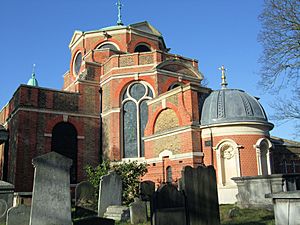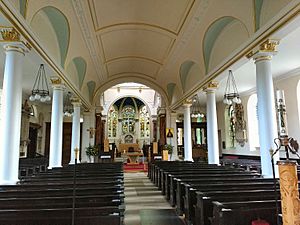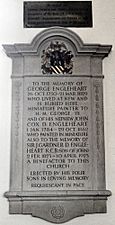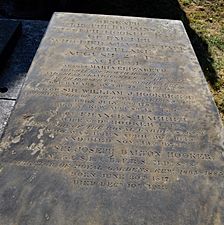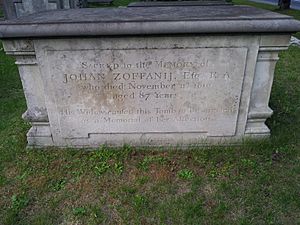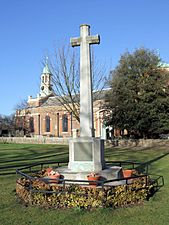St Anne's Church, Kew facts for kids
Quick facts for kids St Anne's Church, Kew |
|
|---|---|
| The Parish Church of St Anne, Kew | |

St Anne's and the Kew war memorial in the spring
|
|
| 51°29′02″N 0°17′16″W / 51.4838°N 0.2879°W | |
| Location | Kew Green, Kew, Richmond TW9 3AA |
| Country | England, United Kingdom |
| Denomination | Church of England |
| History | |
| Founded | 1714 |
| Founder(s) | Queen Anne |
| Dedication | 12 May 1714 |
| Architecture | |
| Years built | 1714 |
| Administration | |
| Parish | St Anne, Kew |
| Deanery | Richmond & Barnes |
| Archdeaconry | Wandsworth |
| Episcopal area | Kingston |
| Diocese | Southwark |
St Anne's Church, Kew, is a historic church in Kew, London. It was built in 1714 and is a very important building. The church is a central part of Kew Green, a large open space.
The churchyard around St Anne's is also special. It holds the tombs of famous artists like Johan Zoffany and Thomas Gainsborough. A well-known French painter, Camille Pissarro, even painted St Anne's Church in 1892.
Contents
Church Services
St Anne's Church holds regular services every Sunday. These include a traditional service called a Said Eucharist. There is also a Sung Eucharist, which means singing is a big part of the service. On the first Sunday of each month, they have a special Choral Evensong with choir singing.
Music at St Anne's
The church is a popular place for concerts. Local groups, like the Kew Sinfonia orchestra, often perform here. The beautiful setting and good acoustics make it a great venue for music.
History of St Anne's Church
St Anne's Church was first built in 1714. The land for the church was given by Queen Anne. At first, it was part of a larger parish in Kingston.
Over the years, Kew grew, and so did the church. This was partly because of support from the royal family. In 1770, King George III paid for the first expansion. This part was designed by Joshua Kirby, who was later buried in the churchyard.
In 1788, St Anne's became its own parish church. More additions were made in 1805, including a new south aisle. A special gallery was also built for the royal family to use. King William IV helped with another expansion in 1837.
Later additions included a mausoleum in 1851 and an eastern extension with a dome in 1882-1884. The church continued to be extended in 1902, 1979, and 1988. In 2013, the inside of the roof was repainted. A new baptismal font was added in 2014 to celebrate the church's 300th birthday.
The church also has a parish hall, built in 1978. It stands next to the church and uses similar building materials. Inside the church, you can see special shields called funerary hatchments. These honor important people who have passed away. There is also a rare display of Queen Anne's coat of arms.
Just outside the church, on the south side, is the Kew war memorial. This large stone cross remembers local people who died in the First and Second World Wars. Their names are listed inside the church on a special monument.
Notable Events at St Anne's
Baptisms
- Francis Perceval Eliot, a soldier and writer, was baptized here on October 9, 1755.
Marriages
- Francis, Duke of Teck married Princess Mary Adelaide of Cambridge at the church on June 12, 1866. Their daughter, "May", later married King George V and became Queen Mary.
Burials
Many notable people have been buried at St Anne's Church:
- William Aiton (died 1793), the first person in charge of the Royal Botanic Gardens, Kew.
- William Townsend Aiton (died 1849), his son, who was also a botanist and royal gardener.
- Franz Bauer (died 1840), an Austrian scientist and artist known for drawing plants. His brother, Ferdinand Bauer, was also a famous botanical artist.
- Professor John Patrick Micklethwait Brenan (died 1985), a British botanist and director of the Royal Botanic Gardens, Kew.
- George Engleheart (died 1829), a painter who created tiny portraits for King George III.
- Thomas Gainsborough (died 1788), a very famous English painter known for his portraits and landscapes.
- Sir William Jackson Hooker (died 1865), a director of Kew Gardens, and his son, Sir Joseph Dalton Hooker (died 1911), who was also a famous botanist and explorer.
- Joshua Kirby (died 1774), an 18th-century painter known for his work on perspective.
- Richard Levett (died 1711), a former Lord Mayor of London and owner of Kew Palace. His family members are also buried here.
- Jeremiah Meyer (died 1789), an English painter of miniature portraits.
- John Smith (died 1888), a botanist and the first curator at the Royal Botanic Gardens, Kew.
- Johan Zoffany (died 1810), a German painter who worked in England.
Formerly Buried at St Anne's
- Prince Adolphus, Duke of Cambridge and his wife Princess Augusta of Hesse-Kassel were buried at the church in 1850 and 1889. However, in 1930, their remains were moved to St George's Chapel, Windsor Castle.
Gallery
Church Exterior
-
East end of the church. The small domed building is the cenotaph of Prince Adolphus, Duke of Cambridge and his wife Princess Augusta of Hesse-Kassel
Church Interior
Tombs and Memorials
-
Memorial to George Engleheart, who is buried at the church
-
Tomb of Thomas Gainsborough
-
Tomb of Johan Zoffany
See also
- The Barn Church, Kew
- Kew Mortuary
- St Luke's Church, Kew
- Anthony Saxton



